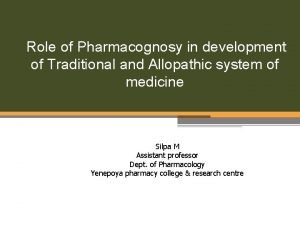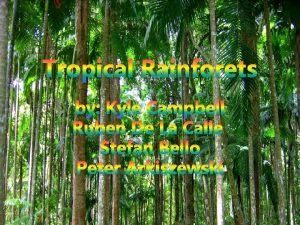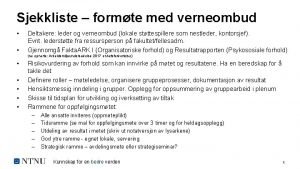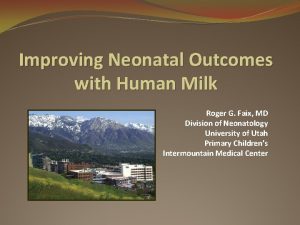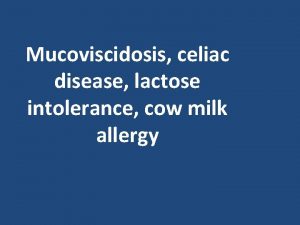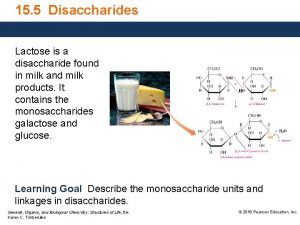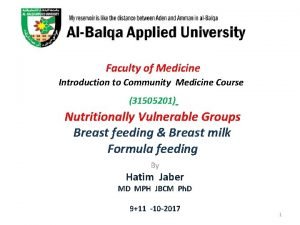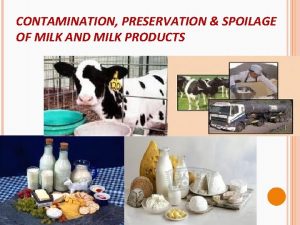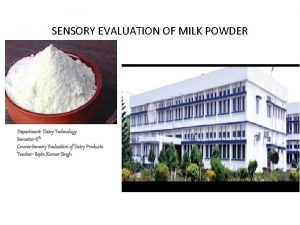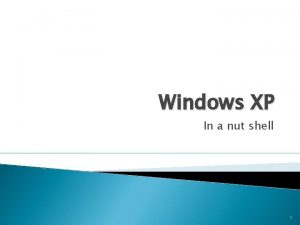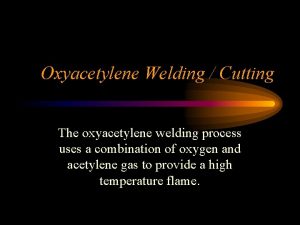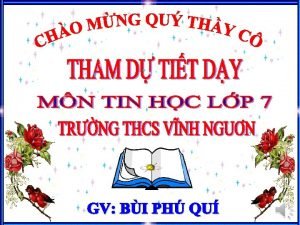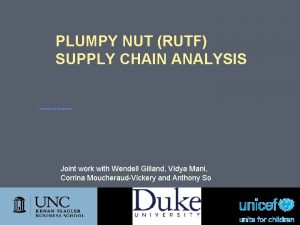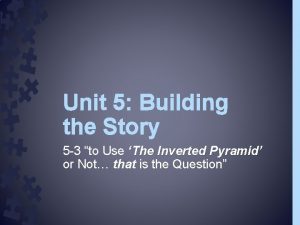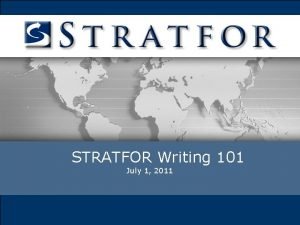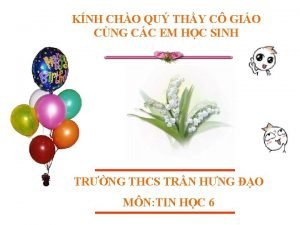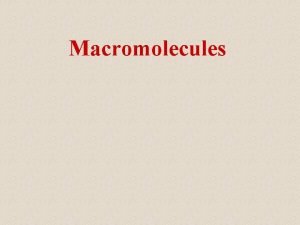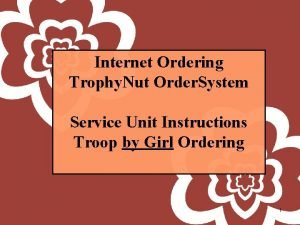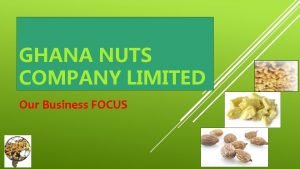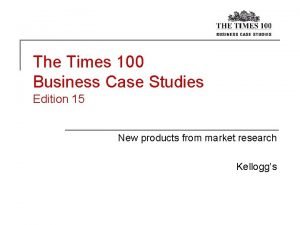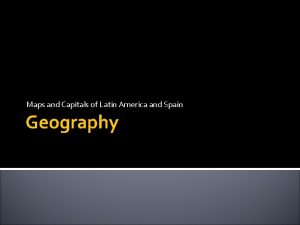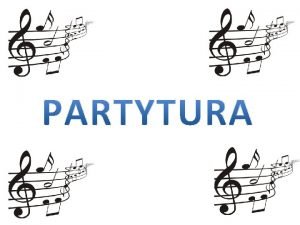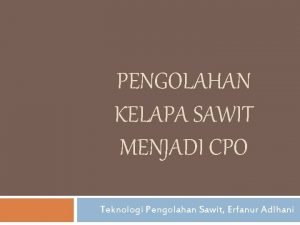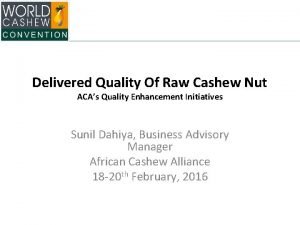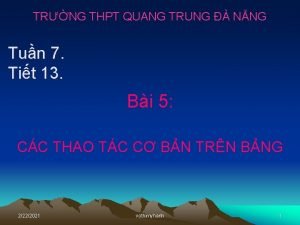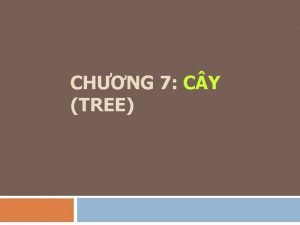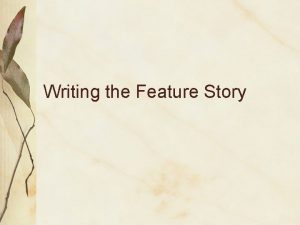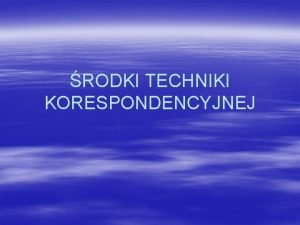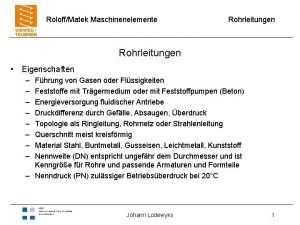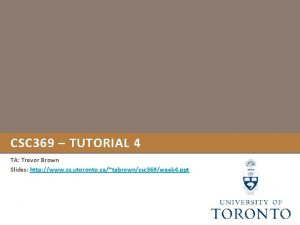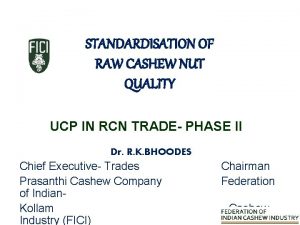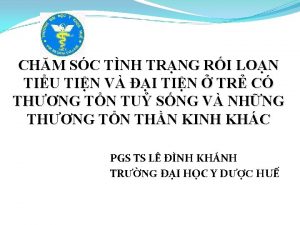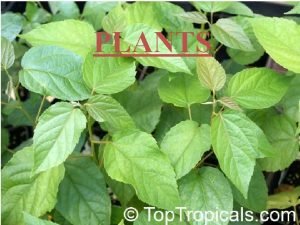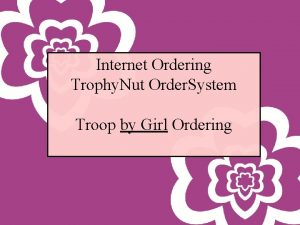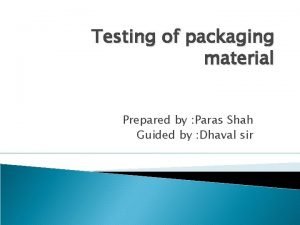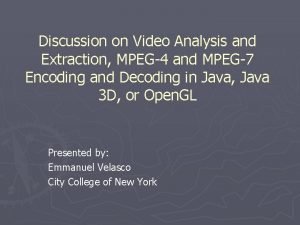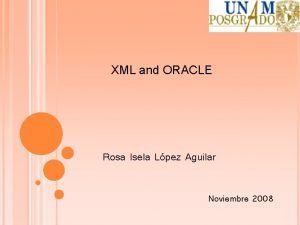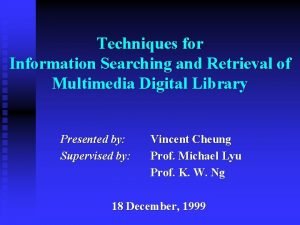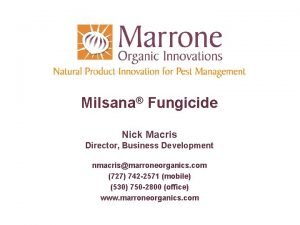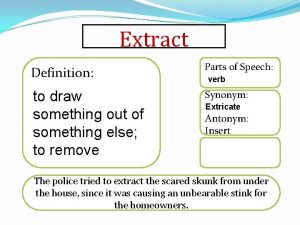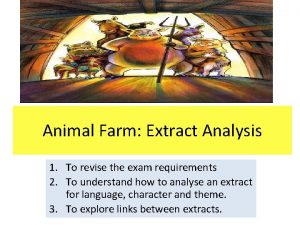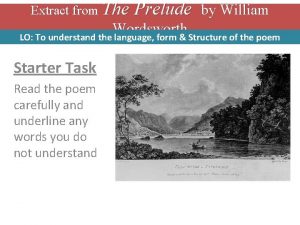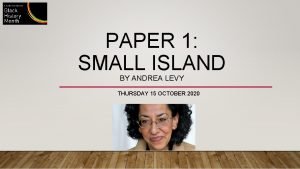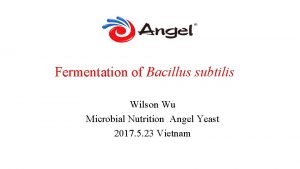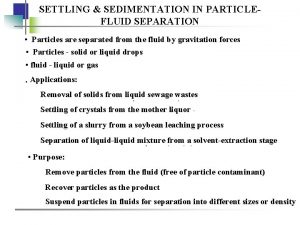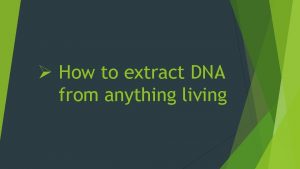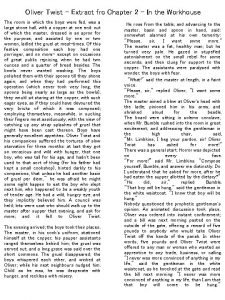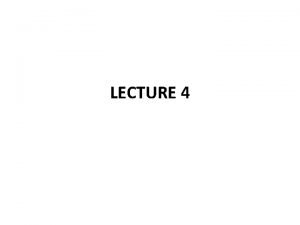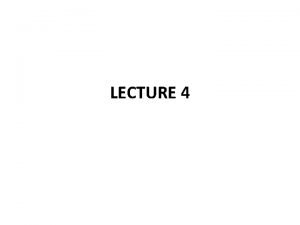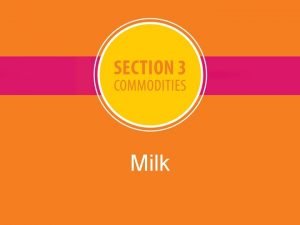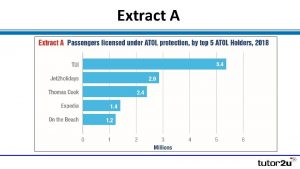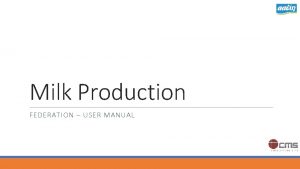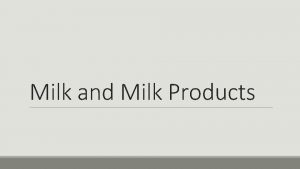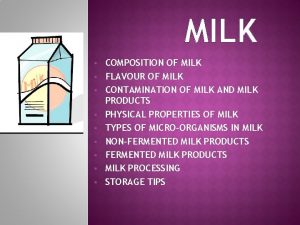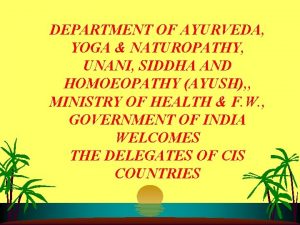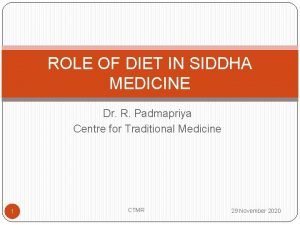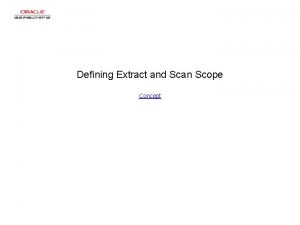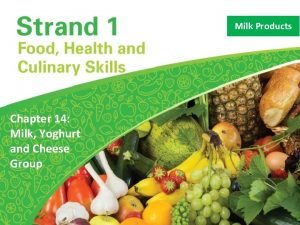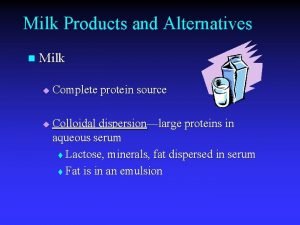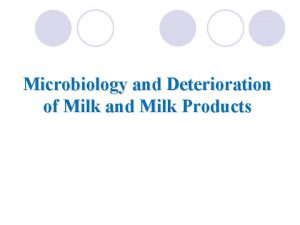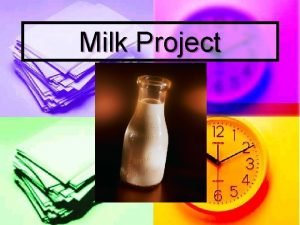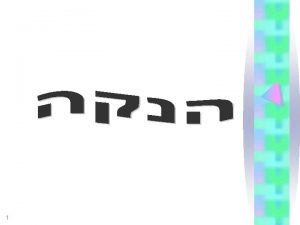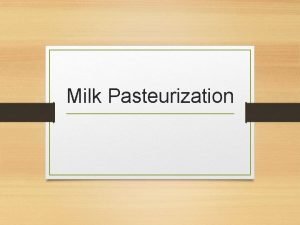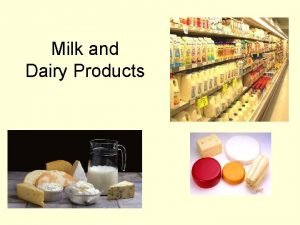Semecarpus anacardium Linn nut milk extract A Siddha



































































- Slides: 67

Semecarpus anacardium Linn. nut milk extract – A Siddha medicine with potent therapeutic effect in experimental mammary carcinoma DR. P. SHANTHI MBBS, MD, Ph. D. , Director , Professor & Head Department of Pathology DR. A. L. M Post-Graduate Institute of Basic Medical Sciences University of Madras Taramani campus, Chennai Tamil Nadu INDIA ALLPPT. com _ Free Power. Point Templates, Diagrams and Charts

ACKNOWLEDGEMENT My grateful thanks to Prof. T. P. Sachidanandam, Ph. D, D. Sc, Emeritus Professor. , Department of Pathology and Professor (Rtd), Dept. of Medical Biochemistry, DR. A. L. M P-G IBMS University of Madras Taramani campus, Chennai Tamil Nadu INDIA


Siddha system of medicine ØOne of the oldest system of traditional medicine - originated 5000 BC - Southern part of India. ØEvolved with Dravidian culture - Dravidian system of medicine. ØMajor contribution from 18 Siddhars or spiritual scientists. ØSiddhars were sages – tremendous powers by way of meditation, Yoga practice and rejuvenation. ØAim – to make the body perfect, imperishable and to promote longevity-emphasis on prevention. ØDrugs categorized into 3 groups: herbal products, minerals, animal products (also physiotherapy and varma, similar to acupressure).

Siddha literature ►Initially bequeathed to select disciples or “sidas" by word of mouth. ►Oral tradition was transcribed on palm leaf manuscripts that now serve as the major repository of the knowledge. ►Steps are being taken by the government for collecting, screening, analyzing and codifying the available manuscripts, printed books, traditional recipes, etc. ►Siddha medicine now incorporated into “AYUSH”.

Semecarpus anacardium Linn. ►Found in Sub-Himalayan regions from Sutlej to Sikkim, tropical and Central parts of India and Western Peninsula of East Archipelago, Northern Australia ►Called the ‘marking nut’ by Europeans, because it was used by washermen as an indelible ink to mark clothes before washing. ►‘Oriental cashew’. ►‘Ballataka’, ‘Bhilawa’ are vernacular names of marking nut.

Semecarpus anacardium Linn.

SA-therapeutic effects ► Semecarpus anacardium Linn. (Family: Anacardiaceae) is a plant wellknown for its medicinal value in Ayurveda, Siddha and even Homeopathy. ► In Ayurveda, the fruit is considered a rasayana for longevity and rejuvenation. ► Incorporated in prescriptions for ü Fevers, skin diseases such as vitiligo ü Excessive menstruation, vaginal discharge ü Malignant growth, haemoptysis ü Deficient lactation ü Constipation, intestinal parasites ü Cardiac disorders and asthma ü Peripheral neuritis, sciatica, facial paralysis and hemiplegia also used in traditional medicine as a neurotonic

SA therapeutic effects ►Nuts and fruits can be used only after curing under medical supervision as they are toxic. ►These purification methods are known as “Shodhana” process in traditional language.

SA- therapeutic effects Extensive scientific investigation of the properties as well as scientific validation of the use of the extract of this fruit has been carried out by various investigators in different parts of the world.

Semecarpus anacardium Linn. Nut milk extract ►Semecarpus anacardium Linn. nut milk extract (SAE) – a decoction of SA in milk and ghee/clarified butter-Siddha drug (Formulary of Siddha Medicine, 1972, IMCOPS). ►Treatment of malignant tumors such as breast cancer, hepatocellular carcinoma and BCR-ABL+ leukemia in experimental animals and cell lines. ►Adjuvant induced arthritis in rats. ►Ongoing studies in our laboratory are aimed at investigating the effects of SAE on streptozotocin induced diabetes mellitus and atherosclerosis in rats.

Mammary Carcinoma ►The most common cancer among women –second leading cause of cancer death (after lung cancer) in women (US Cancer Statistics). ►Breast cancer is now the most common cancer in most cities in India, and 2 nd most common in the rural areas. (National Cancer Registry Programme). ►It accounts for about one fourth of all cancers in Indian women and about half of all cancer related deaths {PBCR (Population Based Cancer Registry) website)}.

SAE 15 -20 years ►Phytochemical analysis. ►Antioxidant and antimutagenic properties using cell free systems. ►in vitro studies in mammary carcinoma-cell lines. ►in vivo studies in experimental mammary carcinoma. ►Toxicological studies in vivo and in vitro using human PBL.

SA-Phytochemistry Protein (g) 26. 40 Fat (g) 36. 40 Minerals (g) 3. 60 Fiber (g) 104. 00 v Semecarpuflavanone Carbohydrate (g) 28. 40 v Jeediflavanone Energy (Kcal) 58. 70 v Galluflavanone Calcium (mg) 29. 50 v Nallaflavanone Phosphorus (mg) 836. 00 Iron (mg) 6. 10 v Semecarpetin Carotene (mg) 0. 00 Thiamine (mg) 0. 38 Riboflavin (mg) 0. 15 Niacin (mg) 2. 70 Rich in flavonoids: v Anacarduflavanone

Assessment of Antioxidant activity of SAE - cell free systems 75 reducing power - Fe 3+–Fe 2+ transformation. Inhibition of nitric oxide radical 60 Cyclic voltammetry-antioxidant property % Inhibition 45 30 15 0 10µg 20µg 40µg 80µg Drug concentration 100µg KA Standard (Rutin) Reducing power by cyclic voltammetry

Antimutagenic effect of SAE Lane 1 : Calf thymus DNA alone Lane 2 : Calf thymus DNA with SAE Lane 3 : Calf thymus DNA induced with Fenton reagent Lane 4 : Calf thymus DNA with SAE induced with Fenton reagent Lane 1 : p. BR 322 plasmid DNA Lane 2 : p. BR 322 plasmid DNA with H 2 O 2 exposed to UV irradiation Lane 3 : p. BR 322 plasmid DNA with SAE and H 2 O 2 exposed to UV irradiation Lane 4 : p. BR 322 plasmid DNA with SAE alone

Toxicological studies

SAE–Effect on normal human PBL Effect of SA on DNA damage induced by Fe 2+and H 2 O 2 Effect of SA on decreased cell viability induced by Fe 2+and H 2 O 2 50 120 a. NS 40 c* d* b* 60 e* e* f* b* 40 30 20 10 20 0 0 Group II Group III Group IV Group VI Group Vll Group VIII Effect of SA on ROS induced by Fe 2+and H 2 O 2 ROS (a. u of DCF Fluroscence) % of cell viability c* 80 % of Tail DNA 100 18 b* 15 12 b* 9 a. NS c* c*d* Group IV Group V e* e* f* Group Vll Group VIII 6 3 0 Group III Group VI

SAE –toxicological studies No toxicity - in in vivo studies on BALB/c mice, Sprague-Dawley rats or Wistar albino rats - histopathological and biochemical parameters.

in vitro CELL LINE STUDIES

SAE - MCF-7 human breast cancer cell line Experimental set up: in vitro studies The cultured human breast cancer cells (MCF-7) were divided in to three groups. Group I - Control (MCF-7) Group II - DMSO control (0. 02%) Group III - Drug treated (45 μg/ml) Studies were also carried out using T 47 D and MDA MB 231 (highly metastatic) breast cancer cell lines

Effect of SAE on MCF-7 breast cancer cell line Cell viability Thymidine incorporation LDH assay 12 MCF 7 100 90 10 80 8 70 % of Viabile Cell LDH IU/µg MTT assay 110 60 6 50 40 4 30 2 20 10 0 Control 15 30 30 Concentration in µg/ml 60 75 0 Control 10 20 30 40 Concentration in µg/ml 50

Mammary carcinoma & Semecarpus anacardium Cell cycle analysis Exponentially growing MCF 7 cells were synchronized to G 1 phase by serum deprivation (0. 5%) in the presence and absence of the drug.

SAE-Effect on MCF-7 cell line Apoptotic changes in breast cancer tissue treated with DMSO (0. 2%) Apoptotic changes in breast cancer tissue treated with SA (75 μg)

DNA fragmentation

MCF-7 : Effect of SAE RT-PCR and Western blot was carried out for the following genes: v. Bcl-2 v. Bax v. Cytochrome c v. Caspase - 3 v. Caspase - 9 SAE induces apoptosis in MCF-7 cells

Possible action of SA ►in vitro studies have shown that SAE exhibits antiproliferative activity, pro-oxidant activity and also induces apoptosis in MCF-7 cells.

in vivo studies

Therapeutic effect of SAE in mammary carcinoma –in vivo Experimental set up: Female Sprague Dawley rats weighing (180 10 g) divided into five groups of six animals each. Group I : Normal healthy controls. Group II : Mammary carcinoma induced with 7, 12 dimethylbenz(a)anthracene (25 mg) dissolved in 1 ml of olive oil through gastric intubation. Group III : Mammary carcinoma induced after three months, treatment was started orally with SAE (200 mg/kg body weight) in olive oil for 14 days daily. Group IV : SA treated control –SAE alone. Sujatha and Sachdanandam, 2002

Mammary Carcinoma & SAE Morphological alterations in breast tissue of control and experimental animals GROUP II GROUPIII Pharmacol Commun 6: 375 -379, 2000 GROUP IV

SAE-effect on Lipid peroxides & Antioxidants Lipid peroxides Parameters Group III Group IV (Control) (DMBA + SA) (SA) SOD 11. 08 ± 1. 09 6. 22 ± 0. 56 a* 9. 02 ± 1. 04 a*b*c. NS 11. 01 ± 1. 00 CAT 120. 17 ± 11. 22 64. 76 ± 6. 75 a* 102. 42 126. 56 ± ± 10. 48 a‡b*c‡ 13. 09 GPx 27. 61 ± 2. 63 13. 82 ± 1. 37 a* 22. 75 ± 2. 24 a‡b*c‡ 28. 02 ± 2. 86 Vit C 1. 98 ± 0. 25 1. 17 ± 0. 13 a* 1. 74 ± 0. 24 a‡b*c† 2. 01 ± 0. 28 Vit E 3. 50 ± 0. 35 1. 17 ± 0. 12 a* 3. 07 ± 0. 32 a†b*c. NS 3. 52 ± 0. 46 GSH 14. 37 ± 1. 57 8. 04 ± 0. 78 a* 12. 02 ± 1. 39 a‡b*c† 14. 18 ± 1. 30

SAE-effect on Antioxidants SAE treatment led to restoration of antioxidants to near normal levels.

SAE-Biochemical parameters in vivo

SAE in mammary carcinomalysosomal enzymes Parameters Group III Group IV (Control) (DMBA + SA) (SAE) ACP 8. 36 ± 0. 88 16. 32 ± 1. 64 a* 12. 38 ± 1. 06 a‡b† 8. 67 ± 0. 85 -D-glu 24. 54 ± 2. 00 47. 44 ± 4. 81 a* 39. 01 ± 3. 94 a*b‡ 24. 81 ± 2. 85 -D-gal 36. 01 ± 3. 69 58. 57 ± 5. 82 a* 46. 03 ± 4. 57 a‡b* 36. 84 ± 3. 83 -NAG 38. 16 ± 3. 59 62. 06 ± 5. 91 a* 53. 49 ± 5. 52 a*b‡ 38. 38 ± 3. 84 Cathepsin D 53. 83 ± 5. 56 77. 75 ± 7. 40 a* 69. 37 ± 6. 94 a†b† 55. 71 ± 5. 59

SAE in mammary carcinoma -on marker enzymes Parameters Group III (Control) (DMBA + Group IV (SAE) SGOT 32. 52± 3. 34 15. 35± 1. 50 a* 22. 13± 2. 06 a*, b‡ 31. 76± 2. 85 SGPT 14. 27± 1. 40 6. 28± 0. 62 a* 9. 59± 0. 85 a*, b* 13. 64± 1. 56 ALP 4. 13± 0. 54 11. 62± 1. 26 a* 8. 02± 0. 78 a*, b* 5. 45± 0. 52 LDH 2. 95± 0. 25 5. 63± 0. 44 a* 4. 30± 0. 38 a‡, b* 2. 96± 0. 39 γ-GT 3. 32± 0. 35 6. 34± 0. 66 a* 5. 30± 0. 53 a*, b‡ 3. 45± 0. 39 5’-nucleotidase 2. 87± 0. 49 5. 33± 0. 56 a* 4. 48± 0. 67 a‡, b‡ 3. 34± 0. 36

SAE –Effect on energy metabolism Electron Transport Chain Complexes Glycolytic & Gluconeogenic Enzymes

SAE - Effect on apoptosis Bcl-2

SAE - pro apoptotic effect CASPASES Caspase-3 Caspase-9 β-actin

SAE- Antiangiogenic property m. RNA expression of VEGF Lane 1 : Control Lane 2 : Mammary carcinoma induced Lane 3 : SA treated Lane 4 : Drug control

SAE in mammary carcinoma membrane stabilizing property Immunohistochemical localization of MMP 9 Control Carcinoma induced Carcinoma treated with SAE Vascular Pharmacology 2007 Jun; 46(6): 419 -26.

SAE-membrane stabilising effect Activities of proteases Parameters /h/ 100 mg protein Normal Collagenase μg hydroxyl proline/ 8. 1 ± 0. 7 Cancerous rats tumour tissue surrounding tissue 10. 3 ± 0. 9 a* 11. 8 ± 1. 1 a* Glycohydrolases protein Treated rats tumour tissue rameters Pa/h/100 surrounding tissue Normal 9. 9 ± 0. 6 d** Treated rats Tumour tissue mg 9. 1 ± 0. 5 c*** Cancerous rats Surrounding tissue βglucosidase 33. 92± μm p- 2. 98 65. 9 ± 5. 29 a* 44. 7 ± 3. 15 b* Surrounding tissue 39. 72 38. 17± ± 3. 52 c* 2. 00 d** nitrophenol Cathepsin B μm p- nitro anline βgalactosidase 34. 7± 3. 3 38. 97 ± 3. 78 51. 82 ± 4. 92 a* 50. 76± 3. 76 a* 43. 06 ± 3. 24 c** 42. 53 ± 3. 94 d** 10. 4 ± 0. 70 Collagenolyt ic cathepsin 27. 3 ± 1. 7 μm hydroxyl proline 16. 7 ± 0. 70 a* 19. 9 ± 1. 03 a* 12. 13 ± 1. 74 c* 13. 56 ± 1. 24 d** 37. 53 ± 2. 61 a* 34. 57 ± 3. 35 c* 31. 12 ± 2. 84 d** 41. 4 ± 3. 2 c* 2. 6 ± 0. 11 d** nitrophenol/ μm p- 27. 5 ± 2. 44 a* 24. 9 ± 1. 78 b* 1. 97 21. 3 ± 1. 78 c* 104. 3 ± 4. 9 d* nitrophenol Nacetyl 45. 97 ± 4. 63 a* 49. 2± 3. 9 b* μm p- βglucuronidase 19. 39 ± Cathepsin D μm tyrosine/ 54. 8± 4. 6 a* galactosaminid 25. 17 ± 43. 6 ± 3. 27 a* 38. 5 ± 3. 54 b* 2. 1 ase μm pnitrophenol/ Vascular Pharmacology 2007 Jun; 46(6): 419 -26. 35. 01 ± 3. 46 c** 0. 45 ± 0. 03 d*

SAE-membrane stabilising effect Matrix Turnover Factors Parameters Normal Cancerous rats Treated rats Tumour tissue Surrounding tissue Tumour tissue Surrounding tissue LOX 52. 6 ± 3. 9 86. 5 ± 6. 7 a* 79. 4 ± 6. 2 b* 69. 5 ± 1. 4 c* 64. 7± 3. 8 d** 23. 4± 1. 6 40. 2 ± 2. 1 a*** 43. 9± 3. 4 b*** 32. 5 ± 1. 9 c*** 30. 8 ± 2. 1 d*** 4. 16 ± 3. 9 6. 8 ± 4. 6 a* 5. 9 ± 3. 7 b* 5. 06 ± 3. 3 c** 5. 12 ± 3. 2 d** 1. 1 ± 0. 2 2. 3 ± 0. 3*** 2. 3 ± 0. 3 b*** 1. 9 ± 0. 1 c*** 1. 3 ± 0. 1 d*** (SFU/ mg protein) ACE (U/ml) Plasminogen Activator (ng of activated plg/h/50μl of homegenate) TNF –α (ng/mg protein) Vascular Pharmacology 2007 Jun; 46(6): 419 -26.

SAE Immunomodulatory activity ►Cancer is associated with decreased immunocompetence. ►Contributes to progression of cancer. ►DMBA induces immunosuppression of both humoral and cell mediated immunity in several different species.

SAE-effect on cell mediated immunity CD 4 and CD 8 counts Param Group Foot pad Group III Group IV eters I CD 4+ 24. 98 11. 48 ± 15. 93 ± 19. 86 ± ± 2. 47 1. 13 a* 1. 48 a*b‡ 1. 97 a‡b‡c† 38. 79 16. 92 ± 26. 91 ± 31. 80 ± ± 3. 51 1. 64 a* 2. 61 a*b* 3. 11 a‡b*c† CD 8+ Leucocyte Lymphocyte Migration inhibition proliferation Cell mediated immunity was supressed in mammary carcinoma –reverted significantly to near normal levels by treatment with SAE

SAE Immunomodulatory activity – Humoral immu nity Humoral immunity & Antibody synthesis Parameter Group I Group II s Antibody Group Ig. G Ig. A Ig. M Group IV III 76. 08 ± 7. 69 titre- 44. 47 ± 55. 36 ± 65. 88 ± 4. 43 a* 5. 56 a*b† 6. 56 a†b*c† 445. 89± 545. 97± 565. 03± 74. 2 44. 52 a* 45. 72 a‡b† 6 a‡b†c. NS 9. 37± 0. 95 a* 12. 59± 15. 72± 1. 12 a*b‡ 1. 25 a†b*c‡ hemaggl utination PFC/106 685. 25± 77. 79 spleen Serum soluble 18. 16± 1. 85 immune complex (PEG indices) Humoral immunity was supressed in mammary ca –reverted significantly to near normal levels by treatment with SAE.

SAE effect on Erythrocyte Protoporphyrin Fluorescence as a Biomarker ØIt has been reported that erythrocytes may be the carriers of fluorophors that accumulate in cancer tissues. Erythrocyte Protoporphyrin Fluorescence is a biomarker and useful in the diagnosis and treatment of malignancies. ØFluorescence emission spectroscopy of blood components are altered in experimental mammary carcinoma and the drug effectively ameliorated these. Parameters Group III Plasma 4. 00± 0. 02 1. 1± 0. 03 a* 3. 7± 0. 02 b* Erythrocyte 2. 51± 0. 01 0. 3± 0. 04 a* 1. 9± 0. 01 b* Erythrocyte membrane 2. 3± 0. 04 3. 3± 0. 01 a* 2. 5± 0. 02 b* Emission characteristics of plasma Erythrocyte and Erythrocyte membrane of the experimental animals excited at 400 nm J of Fluorescence, 2015

Effect of SAE on MUC 1 Expression in Mammary Carcinoma ►The MUC 1 gene which encodes a mucin glycoprotein(s) which is basally expressed in most epithelial cells. In a variety of epithelial tumors and breast adenocarcinoma its transcription is dramatically upregulated. with aberrant expression over the entire cell surface. ►These alterations are considered to be relevant to the abnormal behaviour of cancer cells, such as altered adhesion metastasis. ►This characteristic makes the MUC 1 protein valuable as a marker in breast cancer diagnostics and prognosis.

SAE-effect on MUC 1 expression Serum Mucin 1 levels Mucin 1 expression in mammary tissue Lane 1 - Control sample Lane 2 - Tumour sample Lane 3 - Treated sample Lane 4 - Molecular weight marker

Mammary Carcinoma & Semecarpus anacardium MUC 1

Summary and Conclusions ►Morphologic studies indicated remission of cancer on treatment with SA. ►Increased free radicals, decreased antioxidant status, increased marker enzymes, altered membrane stability, aberrant MUC 1 expression, deranged energy metabolism, and decreased immune competence seen in the cancer state were all restored to near normal on treatment with SA. ►SA exerts these effects by virtue of the action of the constituent flavonoids, polyphenols, glycosides, etc. , which are present in high concentrations.

Summary & Conclusions v. Semecarpus anacardium Linn. nut milk extract, a Siddha formulation, exerts a therapeutic effect in an animal model of mammary carcinoma. v. The active principles which form the basis for these therapeutic properties are yet to be identified. v. Research to isolate the active principles, confirmation of the absence of toxic effects and controlled clinical trials are potential areas for further research.


Conclusion THANK YOU The drug by means of its potent antioxidant, free radical quenching, antimutagenic, immunomodulatory, anti inflammatory, anti angiogenic and membrane stabilizing property has established its efficacy as a potent chemotherepeutic agent. The drug SA fully satisfies this criteria as is evident from its protective nature and non toxic nature. These effects may be attributed to the various phytochemical components present in the drug. Further studies are under way to isolate the major constituent contributing to this therepeutic effect.

Siddha Medicine ØSystem or “Siddham” is the way of life which is the most ancient of all medical systems (Anonymous, 2011 a) and can be considered as the most primordial one. ØSiddha medicine is the conquest of death: “that which ensures prevention against mortality” ØIt is the oldest traditional treatment system generated from Dravidian culture. ØIt flourished in the period of Indus valley civilization (Mukherjee and Wahile, 2006). ØIt is the most ancient indigenous system of medicines of Indian origin practiced exclusively in Tamil Nadu and in some parts of the neighbouring states. ØThe first Tamil Siddha text is the Thirumandhiram written by Thirumoolar dating probably to around 6 th or 7 th century Christian Era or Current Era (C. E) (Zysk, 2008).

Effect of SAE on carbohydrate metabolism Parameters Group III Group V (Control) (DMBA + (SAE) Hexokinase 18. 29 ± 1. 77 34. 20 ± 3. 43 a* 26. 60 ± 18. 49 ± 1. 80 2. 73 a*b* Aldolase 25. 77 ± 2. 57 43. 43 ± 4. 32 a* 34. 68 ± 25. 82 ± 2. 76 4. 35 a*b‡ Phosphoglucoisomerase 21. 99 ± 2. 06 41. 46 ± 4. 11 a* 32. 27 ± 22. 13 ± 2. 04 3. 12 a*b* Glucose-6 -phosphatase 38. 91 ± 4. 24 17. 87 ± 1. 89 a* 25. 73 ± 39. 20 ± 4. 13 2. 56 a*b* Fructose-1, 6 bisphosphatase 50. 79 ± 4. 07 27. 12 ± 2. 68 a* 36. 98 ± 3. 57 a*b* Phytother Res 16 Suppl 1: S 14 -8, 2002 51. 59 ± 4. 26

SAE-Toxicological study ►No marked adverse alterations were observed in hematological and biochemical parameters during the subacute toxicity studies (50, 100, 250 and 500 mg/kg body weight). ►In the subacute treatment, the highest dose (500 mg/kg body weight) alone showed a moderate increase in the level of blood glucose, plasma urea, uric acid and creatinine. Histopathological examination of vital organs showed normal architecture.

Thank You



Complementary & Alternative Medicine (CAM) ØComplementary & Alternative medicine includes practices used in conjunction with or to complement conventional medical treatments. ØHerbal medicines are now considered part of CAM. WHO has launched global strategy on Traditional medicine which provided a framework for policy to assist and regulate CAM to make its use safer and more accessible to more populations. ØThe importance of CAM is underlined by the fact that Institutes such as Richard and Hinda Rosenthal Centre for CAM, Columbia University, New York has been established and is involved in extensive scientific investigation in various aspects of CAM.

CAM & CANCER v. Complementary and Alternative Medicine use is more common among cancer patients. v. Among various types of CAM treatment, herbal medicines were by far the most commonly used group of treatments. v. Leading cancer centers in the world are integrating CAM into a holistic approach in the treatment of malignant tumors exemplified by the Complementary and Alternative Medicine Education (CIMER) website of the MD Anderson Cancer Centre , Houston, USA meant for treating cancer patients.

Siddha System of Medicine üSystem or “Siddham” is the way of life which is the most ancient of all medical systems (Anonymous, 2011 a) and can be considered as the most primordial one. üSiddha medicine is the conquest of death: “that which ensures prevention against mortality” üIt is the oldest traditional treatment system generated from Dravidian culture. üIt flourished in the period of Indus valley civilization (Mukherjee and Wahile, 2006). üIt is the most ancient indigenous system of medicines of Indian origin practiced exclusively in Tamil Nadu and in some parts of the neighbouring states. üThe first Tamil Siddha text is the Thirumandhiram written by Thirumoolar dating probably to around 6 th or 7 th century Christian Era or Current Era (C. E) (Zysk, 2008).

SAE-Toxicological study q Toxicological study – rats - SAE. q The effect of acute (72 h) and subacute (30 days) treatment of the drug with different dosage (75 -2000 mg/kg body weight) on liver and kidney functions and hematological parameters were studied. q The nut extract preparation does not show any detrimental, toxic external symptoms or mortality up to a dose of 2, 000 mg/body weight in laboratory animals (Vijayalakshmi et al. , 2000). Journal of Ethnopharmacology 69(1): 9 -15; 2000.

Semecarpus anacardium Linn. (Family: Anacardiaceae) v. Commonly known as ‘marking nut’ or ‘Oriental cashew’. v‘Ballataka’, ‘Bhilawa’ are vernacular names of marking nut. v. Found in Sub-Himalayan regions from Sutlej to Sikkim, tropic and Central parts of India, Western Peninsula and North Australia. Phytochemistry of Semecarpus anacardium Linn. v. Revealed the presence of biflavonoids, phenolic compounds, bhilawanols, sterols and glycosides. v. TLC, HPLC and HPTLC analysis carried out with the nut and milk extract confirmed the presence of the above said compounds (Sahoo et al. , 2008; Aravind et al. , 2008; Shin et al. , 1999; Nair et al. , 2009). v Chemical and spectral data showed the presence of flavonoids that includes viz: Semecapuflavanone Jeediflavanone Galluflavanone Nallaflavanone Semecarpetin Anacarduflavanone

Semecarpus anacardium Linn. (Family: Anacardiaceae) HPTLC analysis of flavonoids at 254 nm SA nut milk extract SA nut HPTLC analysis of flavonoids at 550 nm SA nut milk extract SA nut

Mammary carcinoma & Semecarpus anacardium Immunomodulatory activity Cell mediated immunity Paramet Group I Group II ers Antibody Group IV III 76. 08 ± 7. 69 titre PFC/106 Group 685. 25± 77. 79 spleen 44. 47 ± 55. 36 ± 65. 88 ± 4. 43 a* 5. 56 a*b† 6. 56 a†b*c† 445. 89± 545. 97± 565. 03± 74. 44. 52 a* 45. 72 a‡b 26 a‡b†c. NS † Serum 18. 16± 1. 85 soluble 9. 37± 12. 59± 15. 72± 0. 95 a* 1. 12 a*b‡ 1. 25 a†b*c‡ Serum immunoglobulin levels immune complex (PEG indices) CD 4 and CD 8 content Parame Group III Group IV ters Effect of SA on antioxidant enzymes in spleen & thymus Parameters CD 4+ Group I Group II 24. 98 ± 11. 48 ± 15. 93 ± 19. 86 ± (Control 2. 47 1. 13 a* 1. 48 a*b‡ 1. 97 a‡b‡c† ) (DMBA) Group III Group IV Parameters (SA) CD 8+ 38. 79 ± 16. 92 ± 26. 91 ± 31. 80 ± 3. 51 1. 64 a* 2. 61 a*b* 3. 11 a‡b*c† CAT GPx (DMBA) (DMBA + SA) SOD Group III Group IV (Control) 18. 04 ± 8. 09 ± 13. 35 ± 17. 51 ± 1. 60 0. 74 a* 1. 27 a*b* 1. 73 164. 42 ± 108. 63 ± 135. 24± 169. 70 ± 15. 98 10. 76 a* 13. 67 a*b* 17. 40 36. 62 ± 17. 58 ± 26. 53 ± 37. 61 ± 3. 79 1. 82 a* 2. 61 a*b* 3. 94 Comparative Clinical Pathology, 2012 SOD CAT GPx 11. 08 ± 6. 22 ± 8. 37 ± 1. 09 0. 56 a* 0. 84 a*b* 11. 01 ± 1. 00 120. 17 ± 64. 76 ± 90. 93± 120. 56 ± 11. 22 6. 75 a* 9. 14 a*b‡ 11. 19 27. 61 ± 13. 82 ± 19. 59± 27. 52 ± 2. 63 1. 37 a* 2. 03 a*b* 2. 66

SA-Phytochemistry ►Revealed the presence of biflavonoids, phenolic compounds, bhilawanols, sterols and glycosides. ►TLC, HPLC and HPTLC analysis carried out with the nut and milk extract confirmed the presence of the above said compounds (Sahoo et al. , 2008; Aravind et al. , 2008; Shin et al. , 1999; Nair et al. , 2009). ►Chemical and spectral data showed the presence of flavonoids that includes, v Galluflavanone v Semecapuflavanone v Nallaflavanone v Semecarpetin v Jeediflavanone v Anacarduflavanone
 Role of pharmacognosy in traditional system of medicine
Role of pharmacognosy in traditional system of medicine Binominális nomenklatúra
Binominális nomenklatúra Harpy eagle eating berries
Harpy eagle eating berries Linn rasch aune
Linn rasch aune Human milk vs cow milk
Human milk vs cow milk Milk for toddlers with milk allergynon dairy
Milk for toddlers with milk allergynon dairy Disaccharide found in milk
Disaccharide found in milk Human milk vs cow milk
Human milk vs cow milk Contamination of milk and milk products
Contamination of milk and milk products Sensory evaluation of dairy products
Sensory evaluation of dairy products Windows nut client
Windows nut client Weldequip
Weldequip Nút lệnh print preview nằm ở đâu
Nút lệnh print preview nằm ở đâu Plumpy nut
Plumpy nut Nut graph
Nut graph Nut graf
Nut graf Nut scaping
Nut scaping ý nghĩa nút lệnh save
ý nghĩa nút lệnh save What macromolecules make up a macadamia nut
What macromolecules make up a macadamia nut Trophy
Trophy Ghana nut
Ghana nut The times 100 business case studies
The times 100 business case studies Latin america and spain map
Latin america and spain map Decimani
Decimani Berat jenis nut kelapa sawit
Berat jenis nut kelapa sawit Ambihelical hex nut
Ambihelical hex nut The nut job awful movies wiki
The nut job awful movies wiki Cashew nut
Cashew nut để thêm bản ghi mới ta nháy nút nào
để thêm bản ghi mới ta nháy nút nào đếm số nút lá trên cây c++
đếm số nút lá trên cây c++ Nut graph
Nut graph Feature lead examples
Feature lead examples Maszyna do pisania nut
Maszyna do pisania nut Feder und nut
Feder und nut Spintorq
Spintorq In drilling machine the linear motion of drill is called as
In drilling machine the linear motion of drill is called as Twin letters candy
Twin letters candy Csc369
Csc369 Raw cashew nut quality
Raw cashew nut quality Tật nứt đốt sống
Tật nứt đốt sống Nut graf examples
Nut graf examples Nut graf examples
Nut graf examples Lewis foundation bolt drawing
Lewis foundation bolt drawing Hexagonal nut
Hexagonal nut Active principle of marking nut
Active principle of marking nut Edlanice
Edlanice How to write a feature story
How to write a feature story Macbeth edexcel questions
Macbeth edexcel questions Collapsibility test for plastic containers
Collapsibility test for plastic containers Extract text
Extract text Extract captions from video
Extract captions from video Extract xml oracle ejemplos
Extract xml oracle ejemplos What is the extract about
What is the extract about English language eduqas past papers
English language eduqas past papers Extract text
Extract text Catechol oxidase and potato extract lab report
Catechol oxidase and potato extract lab report Milsana
Milsana Extricate antonym
Extricate antonym Animal farm extract analysis
Animal farm extract analysis Extract of the prelude
Extract of the prelude Small island extract
Small island extract Yeast extract fm803
Yeast extract fm803 Hindered settling
Hindered settling Macbethmimi
Macbethmimi Extract from jane eyre
Extract from jane eyre How to extract dna from anything living
How to extract dna from anything living Oliver twist extracts
Oliver twist extracts Power bi extract transform load
Power bi extract transform load
